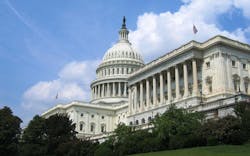Getting insight into the regulatory process: Part 1
As the confirmation hearings for President-elect Donald Trump’s cabinet progress this week (with the one for Elaine Chao, the incoming Secretary of Transportation, perhaps the most noteworthy for trucking) many in the freight industry may very well be thinking to themselves, “how will these appointments impact the rules and regulations governing my business?”
It’s a critical question, one I’ve touched on in this space before, but one Congress is currently taking steps to mitigate as this story illustrates.
Yet a deeper question one might ask is “how” the whole regulatory process gets rolling to begin with: how and why are particular rules crafted? And will how a regulation gets formulated determine whether it experience timely passage or not?
I sat down with David Kelly, a longtime automotive industry expert who served as acting administrator for the National Highway Traffic Safety Administration (NHTSA) under President George W. Bush, to get some insight into the whole regulatory process, which I’m going to break up into several blog posts this week.
Currently president of consulting firm Storm King Strategies, Kelly has spent many years dealing with regulatory efforts both inside and outside of government.
For starters, he noted that the “regulatory flow” devolves mainly from priorities set by the President. “For example, during the Bush administration, transit did not have as high a priority as it did under the Obama administration,” Kelly explained to me. “The focus will be set by the President; that is what the [Transportation] Secretary follows.”
And anytime you have a change in administration, even to one with holdovers from a previous administration – which obviously isn’t going to happen in Trump’s presidency – Kelly stressed that there will be a big change in priorities.
“[Transportation] Secretary [Norman] Mineta used to say that everyone at DOT [the U.S. Department of Transportation] is staff, even the secretary,” Kelly pointed out. “Everyone has a higher pecking order; the only one who doesn’t is the president. At the end of the day, we are all staff.”
OK, fair enough. But how does that affect the rulemaking process?
Kelly noted that there are a few key ways regulations are created: A third party can ask the agency to initiate a rulemaking; an agency can initiate the rulemaking itself because data or trends they see warrant it; or they can be told to make a rule by Congress.
“Those are the three ways a rulemaking can really begin,” he said. “But starting the [rulemaking] process and finishing the process are two completely different things.”
Here’s why: If the process is started by the agency itself or agency is directed to by Congress, the likelihood of it getting done is a lot higher than if somebody outside of government asks the agency to open up a rulemaking.
“Those are the ones that take a very long time because they are just not a priority for the agency to finish it,” Kelly explained.
Why is that? “There are only a handful of people within each [federal] agency – not as many as you think – who are working on rulemakings,” he said. “The people working on a Congressional-directed rulemaking, agency-directed rulemaking or one requested by the public, they are the same people.”
Thus some serious “triage,” for the lack of a better term, needs to occur.
“For example, when I was at NHTSA, we had one economist. And for every rulemaking, you have to do an economic impact statement – and I had just one guy at the agency that was doing all that stuff. So do you want me to take him off the CAFE [Corporate Average Fuel Economy] rulemaking, which is something that everyone said was a priority, in order to do another one? Because, in order to a different one, we would not have been able to do the CAFÉ one. So keep in mind there is always a resource issue when it comes to getting everything done.”
That’s not necessarily a bad thing, though, Kelly stressed.“I would make the argument, that, if you had everyone you wanted working on rulemakings, you’d have way too many rulemakings. You would just be killing innovation and business development and all sorts of things by overregulation,” he explained.
So that’s why it might be by design NOT to have too many regulatory-making staffers at federal agencies - and thus why every agency has a priority rulemaking plan, Kelly noted.
Congress is also getting a lot more direct about the rulemaking process, too, he said. “They used to just say, ‘issue a rulemaking.’ Well, take backup cameras: that took eight years to get issued. So now the language from Congress is getting smarter, saying things like ‘initiate a rulemaking by’ or ‘issue a rulemaking by.’ Now there is a ‘back end’ to the process.”
Still, when mixed together, all the outside advocating, policy directives and the priorities of the administration, create a “lot of different layers” for a rulemaking process to get through. “That is when the process can go from 12 months to three years,” Kelly said.
“In a perfect world, it would take nine months to get a rulemaking done from beginning to end,” he added. “The reality is that it takes one to two years, and if the rule is controversial in any way, it’ll take a lot longer than two years.”
Tomorrow, we’ll continue this regulatory discussion with Kelly by looking at the specific rulemaking steps that need to be taken along the way – and what happens to such efforts if they stray from the “scope” of the rule being crafted.


